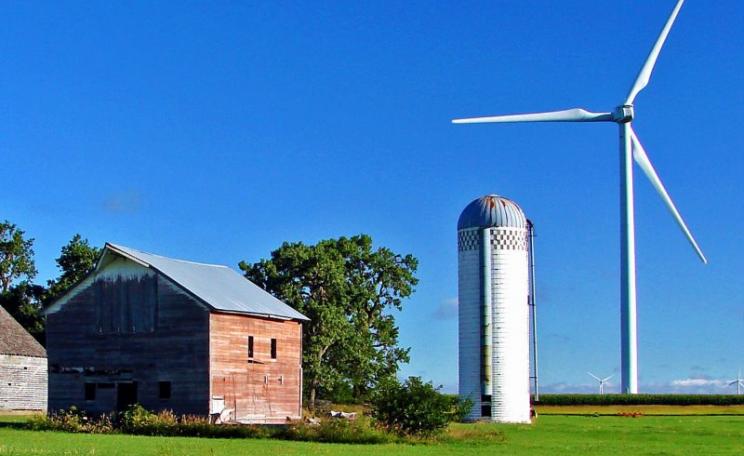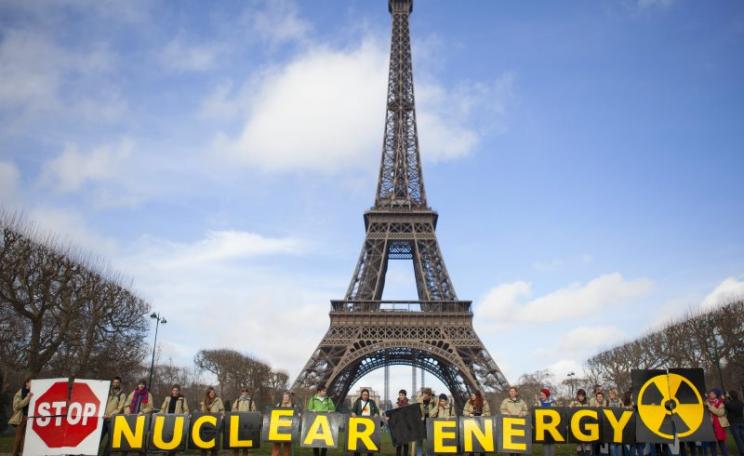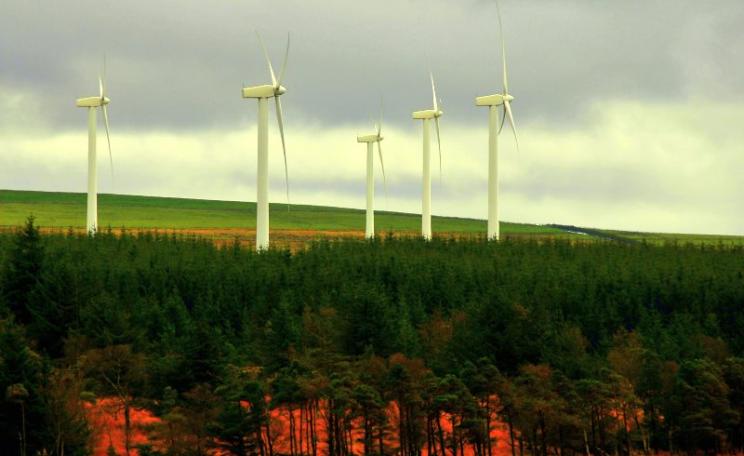Using 0.005% concentration uranium ores, a nuclear reactor will have a carbon footprint larger than a natural gas electricity generator. Also, it is unlikely to produce any net electricity over its lifecycle.
The UK government is committed to massively subsidising new nuclear reactors, based on the claim that they generate 'low carbon' electricity.
But what is the carbon footprint of nuclear power? I have trawled the literature and found that there is no scientific consensus on the lifetime carbon emissions of nuclear electricity.
Remarkably, half of the most rigorous published analyses have a carbon footprint for nuclear power above the limit recommended by the UK government's official climate change advisor, the Committee on Climate Change (CCC).
According to the CCC, if we are to avoid the worst effects of climate change, by 2030 all electricity should be generated with less than 50 grams of carbon dioxide emitted for each kilowatt-hour (50 gCO2/kWh).
Since all new generators have lifetimes well over 20 years, I believe this limit should be imposed on all new electricity supply systems here and now - and all the more so for those with lifetimes spanning many decades.
Note that thanks to long construction times for the EPR design and a forthcoming legal challenge, it's entirely possible that the planned Hinkley C reactor will not be completed until 2030 or beyond. It will then be subsidised for the first 35 years of its projected 60 year lifetime - taking us through until 2090.
What is the carbon footprint of renewable electricity?
When comparing the carbon footprints of electricity-generating technologies, we need to take into account carbon dioxide emitted in all stages in the life of the generator and its fuel. Such a study is called a life cycle analysis (LCA).
There are other gases such as methane that are more dangerous greenhouse gases than carbon dioxide. The most reliable LCAs take all greenhouse gases into account and present equivalent carbon dioxide emissions.
In a recent paper in Energy Policy, Daniel Nugent and Benjamin Sovacool critically reviewed the published LCAs of renewable electricity generators. All the renewable technologies came in below the 50 gCO2/kWh limit.
The lowest was large-scale hydropower with a carbon footprint one fifth of the CCC limit (10 gCO2/kWh). A close second was biogas electricity from anaerobic digestion (11 gCO2/kWh). The mean figure for wind energy is 34 gCO2/kWh, and solar PV comes in a shade under the 50g limit, at 49.9 gCO2/kWh. Bear in mind that rapidly evolving PV technology means that this last figure is contantly falling.
What's the carbon footprint of nuclear power?
There have been nearly three hundred papers on the carbon footprint of nuclear power in scientific journals and reports in recent years. Two peer-reviewed papers have critically assessed the literature in the way Nugent and Sovacool compared renewable LCAs.
Using 0.005% concentration uranium ores, a nuclear reactor will have a carbon footprint larger than a natural gas electricity generator. Also, it is unlikely to produce any net electricity over its lifecycle.
The first was by Benjamin Sovacool himself [1]. He reviewed 103 published LCA studies and filtered them down to 19, which had an acceptably rigorous scientific approach. The carbon footprints ranged from 3 to 200 gCO2/kWh. The average carbon footprint was 66 gCO2/kWh, which is above the CCC limit.
In 2012, four years after Sovacool's paper, Ethan Warner and Garvin Heath found 274 papers containing nuclear LCAs [2]. They filtered them down to 27 for further consideration. These yielded 99 estimates of carbon footprints which the authors describe as "independent".
Their data for carbon emissions ranged from 4 to 220 gCO2/kWh. They did not report an average but rather a median value: half the estimates were below 13 gCO2/kWh.
These two reviews of the published literature, often called meta-analyses, produced conflicting results. One suggests the carbon footprint is above the CCC limit, the other well below.
Looking in more detail at the Warner and Heath meta-review it becomes clear that their 99 estimates are not all 'independent' - in the sense of independent from each other - as they come from only 27 papers.
In fact, a significant number of their 99 estimates come from LCAs that have varied one or more of the assumptions in their calculations: for example the concentration of uranium in the ore, the geographic location of the reactor or the type of reactor.
Treating these variations as 'independent', as Warner and Heath do, gives undue weight to studies that report a large number of different assumptions for the same LCA model. We will see that these are mainly analyses which report low carbon footprints.
It is therefore not surprising that Warner and Heath's median is so much lower than Sovacool's average. I believe it more appropriate to present these different estimates from the same LCA as an average and a range of values. This I have done for the most rigorous of the LCAs.
The five stages of nuclear electric generation
Another concern with the Sovacool and Warner-Heath reviews is that among their selected LCAs there are, in both reviews, some analyses that do not include all the five stages in the nuclear lifecycle.
Greenhouse gases are emitted in all stages of the lifecycle of a nuclear reactor: construction, operation, fuel production, dismantling and waste disposal. Leaving out any of these five stages will bias estimates towards lower values.
The last two contributions, dismantling and waste disposal are particularly difficult to estimate. Not many commercial reactors have been fully decommissioned. Also there is still no scientific or political consensus on the approach to be used for the long-term storage of waste.
The fuel preparation contribution is also problematic. Considerable amounts of carbon are released in the mining, milling and separation of the uranium from the ore. Also the carbon emitted is very dependent on the concentration of uranium in the ore.
It's important to appreciate that these three problematic contributions, fuel production, dismantling and waste disposal are either non-existent or small contributions in the case of electricity generation by renewable technologies. Estimates of the carbon footprint of renewably generated electricity therefore should be much more reliable than those for nuclear.
Selecting the most rigorous analyses
I have reviewed the LCAs of all the light water reactors and pressurised water reactors that passed the selection procedures of either the Sovacool or the Warner-Heath meta-analyses. I have further refined their selection by excluding any LCA that does not estimate a carbon footprint for all five stages of the life cycle. Only eight LCAs survive.
The figure shows the carbon footprints of the eight LCAs that pass this more rigorous test. All eight LCAs considered different assumptions that resulted in a range of estimates for the carbon footprints indicated by the vertical error bars. The circles show the average carbon footprint in the range of estimates.
The most important point to notice in the figure is that four of the circles fall below the horizontal broken line at 50 gCO2/kWh and four above. Half the most rigorous of the published LCAs are below the CCC limit and half are above.
The conclusion from the eight most rigorous LCAs is therefore that it is as likely that the carbon footprint of nuclear is above 50 gCO2/kWh as it is below. The evidence so far in the scientific literature cannot clarify whether the carbon footprint of nuclear power is below the limit which all electricity generation should respect by 2030 according to the CCC.
Another important point to notice in the figure is that the spread of the estimates is smallest for the two lowest LCAs (references 4 and 5). These two LCAs only considered a small range of assumptions in their LCA models. However they considered a large number of different assumptions (13 in the first reference and 9 in the second) compared with many of the higher carbon footprint LCAs.
Warner and Heath consider these 22 estimates as 'independent'. This is why the median (13 gCO2/kWh) of their 99 estimates is so low compared to Sovacool's average. I am surprised that the peer-reviewers for the Journal of Industrial Ecology did not object to this seriously flawed methodology.
Why is there such a large spread of LCA results?
Two of the eight LCAs deserve particular mention. They suggest some reasons for the large spread in the results. They are taken from the publication of Jef Beerten and collaborators [3], who decided to do a complete re-analysis of three previously published LCAs: one with a low carbon footprint, one with a medium estimate and one with a high value of carbon footprint.
Their extensive re-analyses help to clarify the reasons for the large spread in results. The Berteen re-analyses are clearly independent of the original analyses, hence both the original results and the re-analyses are in the figure. The low LCA and its re-analysis were excluded as they did not include a waste contribution.
Beerten and his colleagues conclude that the uncertainties in the three problematic contributions - fuel production, dismantling and waste disposal - are mainly responsible for the wide variation of estimates.
They also point out that the estimates depend strongly on the assumptions made about the carbon footprint of the energy that has to be supplied, in particular in extraction, preparation and enrichment of the fuel. This point is illustrated in the figure.
The vertical error bars on the two Beerten re-analyses [3] indicate the limits in the variation in the nuclear carbon footprint resulting from assumptions about the greenhouse emissions of the energy mix used to produce the nuclear fuel. The Beerten re-analyses also confirm that the carbon footprint of nuclear power depends strongly on the concentration of the uranium in the ore. This was first identified by Storm van Leeuwen, an author of the LCA in reference [9].
Using 0.005% ore, nuclear has higher carbon emissions than gas
Nuclear fuel preparation begins with the mining of uranium containing ores, followed by the crushing of the ore then extraction of the uranium from the powdered ore chemically. All three stages take a lot of energy, most of which comes from fossil fuels. The inescapable fact is that the lower the concentration of uranium in the ore, the higher the fossil fuel energy required to extract uranium.
Table 12 in the Berteen paper confirms the van Leeuwen result that for ore with uranium concentration around 0.01% the carbon footprint of nuclear electricity could be as high as that of electricity generation from natural gas.
This remarkable observation has been further confirmed in a report from the Austrian Institute of Ecology by Andrea Wallner and co-workers. They also point out that using ore with uranium concentration around 0.01% could result in more energy being input to prepare the fuel, build the reactor and so on, than will be generated by the reactor in its lifetime.
According to figures van Leeuwen has compiled from the WISE Uranium Project around 37% of the identified uranium reserves have an ore grade below 0.05%.
A conservative estimate for the future LCA of nuclear power for power stations intended to continue operating into the 2090s and beyond would assume the lowest uranium concentration currently in proven sources, which is 0.005%.
On the basis that the high concentration ores are the easiest to find and exploit, this low concentration is likely to be more typical of yet to be discovered deposits.
Using 0.005% concentration uranium ores, the van Leeuwen, Berteen and Wallner analyses agree a nuclear reactor will have a carbon footprint larger than a natural gas electricity generator. Also, it is unlikely to produce any net electricity over its lifecycle.
What is the carbon footprint of the 'Third Generation' reactor at Hinkley Point C?
All the LCAs in the published meta-reviews refer to electricity generators which have already been built. In addition to the problems described above there are at least three further difficulties in assessing the carbon footprint of third generation reactors:
-
The two prototypes for the European Power Reactor (EPR) proposed for Hinkley Point are still in the construction stage and are well behind schedule. In all engineering projects the completion of a prototype results in modifications to the construction that cannot be predicted beforehand. That is the reason for building a prototype. Also, until the reactor has run for a period, it will not be clear if it will achieve its design power output and how long it will operate between refuelling. These latter two factors are important in estimating the total amount of electricity the EPR will generate in its lifetime. The carbon emissions are divided by the total amount of energy to get a carbon footprint.
-
The EPR is far bigger and more complex, than any existing nuclear reactor, or indeed any electricity generating system ever built. Major design modifications have to be included to incorporate lessons learnt from the Fukushima disaster. This all means not only has the cost of the EPR risen, and will continue to rise with the prototype modifications, but also carbon emissions during the construction stage will be expected to be higher than these of current reactors.
-
The intention is that fuel rods of the EPR will remain longer in the core than in today's reactors in an attempt to reduce the cost of the electricity. This will mean that the spent fuel will be more radioactive resulting in new challenges in dismantling reactors and in dealing with the waste. Inevitably, this will lead to higher carbon footprints.
Given these three factors it is surprising that a report commissioned by the CCC in 2013 claims a carbon footprint for the EPR of 6 gCO2/kWh, comparable with the lowest two LCAs in the figure.
The report is from the company Ricardo-AEA, formed in 2012 when Ricardo acquired AEA Technology, itself a spin-out from the United Kingdom Atomic Energy Authority. Their analysis makes the astonishing assumption that both the EPRs at Hinkley Point C will operate at 1 GW above their design power for 85% of every year over a 60 year lifetime.
This is a remarkably optimistic projection that gives an unrealistically high total for electrical energy generated in a lifetime. But this is only one reason for the very low carbon footprint.
The Ricardo-AEA report quotes the spread of results from the Warner-Heath analysis. However, they compare their result with six other LCAs that all have carbon footprints below 8 gCO2/kWh. Three are from reference [5] and three are not included in the Warner-Heath study.
The report does not explain why their result differs so much from the results of the majority of the LCAs in the Warner-Heath review. Massive amounts of taxpayers' money should not be committed to this project on the basis of such a flimsy scientific assessment of environmental impact.
An estimate of the carbon footprint of the EPR
In my book, The Burning Answer: a User's Guide to the Solar Revolution, I discuss a simple comparison of the LCAs of the EPR and a large dam (or probably dams) producing the same amount of power.
The carbon footprint of hydropower, 10 gCO2/kWh, is much better known than nuclear. Many large dams have been constructed and uncertainties such as carbon emissions during fuel production and long term storage of waste do not apply to hydropower.
First let's compare the construction costs. The cost of building the first 1.6 GW EPR at Hinkley Point is around five times higher than the cost of building the hydropower dams which provide the same electrical power. This higher price suggests higher carbon emissions.
The EPR price reflects the high cost of more sophisticated nuclear engineering, manufacturing and transporting a steel pressure vessel, expensive high precision nuclear components, steam generators and safety systems.
Many of these additional costs for the nuclear option result from burning fossil fuels directly in manufacture or transport or in the generation of electricity in all stages of construction. The fact that the EPR costs five times the hydropower option suggests the construction could result in up to five times larger carbon emissions than dams that give the same power.
This approach was first suggested by Hans Bethe, the physics Nobel Prize laureate, in the 1960s, and has been widely used by both companies and governments as a first estimate of their carbon footprints.
Assuming the reactor and the dams have the same lifetimes, and generate for the same time each year, the carbon footprint in grams of CO2 for each kWh of energy could be up to five times higher for the EPR than for hydropower: hence around 50 gCO2/kWh.
But note: this rough estimate is only for the carbon dioxide emitted during construction. It ignores the carbon emitted during the problematic three nuclear stages, fuel production, dismantling and waste disposal.
This simple argument suggests to me that - as for the first and second generation - there is as yet no solid scientific evidence that the carbon footprint for the EPR will be below the CCC recommendation of 50 gCO2/kWh. Indeed once the additional carbon emissions are taken into account, it's certain to be considerably above that figure.
So the claim that the carbon footprint of the EPRs planned for Hinkley C will be as low as 6 gCO2/kWh, less even than hydropower - as claimed in the Ricardo-AEA report commissioned by the CCC - is wholly incredible.
What should be done now?
The UK government should follow good engineering and investment practice and undertake full due diligence before signing a contract to subsidise the EPR. This should include a complete and thorough LCA of greenhouse gas emissions including data on the performance of a working prototype.
The likely Austrian appeal against the European Commission's approval of the subsidy may delay the contract signing beyond the 2016 completion date for the EPR. In any case, it is extremely bad engineering - and toxic investment practice - to sign a contract before a prototype operates. The LCA should be subject to thorough review by independent experts as is the case for technical due diligence for commercial investment.
The Hinkley C project is surely Britain's largest and most expensive electricity generating project. It is certainly the most complex. At the present time the UK government is keen to sign a contract with French and Chinese companies, many of which are owned by their governments, to build the project.
The contract will commit the UK public to paying heavy subsidies and may be signed before it is known if the prototype works or what its environmental impact will be. This would be engineering, investment and, possibly, political stupidity.
Conclusions
There is no consensus in the scientific literature as to the carbon footprint of existing nuclear reactors. I have more confidence in the six highest LCAs because two of them have been independently re-assessed and - in contrast to the two lowest LCAs - the higher analyses have taken realistic account of the uncertainties in the three most problematic parts of the nuclear life cycle.
As all six are either above, or have error bars that reach above, the CCC's 2030 threshold of 50 gCO2/kWh, the balance of the evidence of the six most robust LCAs is that the carbon footprint of nuclear power is above the CCC's recommended limit.
And of course these figures apply to existing nuclear power stations, not the EPR design planned for Hinkley C. As we have seen, the EPR's very high cost suggests considerably higher emissions in the construction stage. So too does the fact that, over its projected 60-year lifetime, it will be using uranium from very low quality ores.
The likely delay due to the Austrian appeal against the European Commission's decision on the EPR subsidy offers an opportunity for a full, independent and peer reviewed assessment of the environmental impact of this complex and expensive new technology.
Thanks! The author wishes to acknowledge the valuable assistance of Neal Powell, Benjamin Sovacool and Storm van Leeuwen.
Keith Barnham is Emeritus Professor of Physics at Imperial College London, where his group developed a third generation solar cell with three times the efficiency of current rooftop PV. He co-authored the only published study of plutonium production in UK civil reactors. He is author of The Burning Answer: a User's Guide to the Solar Revolution, published by Weidenfeld and Nicolson. ISBN 9780297869634.
References:
-
Benjamin K. Sovacool, Energy Policy, 36, 2940, (2008), sovacool@vt.edu
-
Ethan S. Warner and Garvin A. Heath, Journal of Industrial Ecology, 16, S73, (2012)
-
Jef Beerten, Erik Laes, Gaston Meskens, William D'haeseleer, Energy Policy, 37, 5056, (2009)
-
C. Lecointe, D. Lecarpentier, V. Maupu, D. Le Boulch, and R.Richard. 2007. "Final report on technical data, costs and life cycle inventories of nuclear power plants." EDF R&D. www.needs-project.org/RS1a/RS1a%20D14.2%20Final%20report%20on%20nuclear.pdf
-
R. Dones, C. Bauer, R. Bolliger, B. Burger, T. Heck, A. Roder, M. F. Emmenegger, R. Frischknecht, N. Jungbluth, and M. Tuchschmid, 'Life cycle inventories of energy systems: Results for current systems in Switzerland and other UCTE countries', EcoInvent Report No. 5. Villigen, Switzerland: Paul Scherrer Institut Villigen, Swiss Centre for Life Cycle Inventories, (2007).
-
V.Fthenakis and H.C.Kim, Energy Policy, 35, 2549, (2007)
-
M. Lenzen, C. Dey, C. Hardy, and M. Bilek., 'Life-cycle energy balance and greenhouse gas emissions of nuclear energy in Australia', Report to the Prime Minister's Uranium Mining, Processing and Nuclear Energy Review (UMPNER). Sydney, Australia: Integrated Sustainability Analysis, University of Sydney.
-
Koji Tokimatsu, Takanobu Kosugi, Takayoshi Asami, Eric Williams, Yoichi Kaya, Energy Policy 34, 833, (2006).
-
J. W. Storm van Leeuwen and P. Smith, 'Nuclear Power: The Energy Balance', www.stormsmith.nl.







